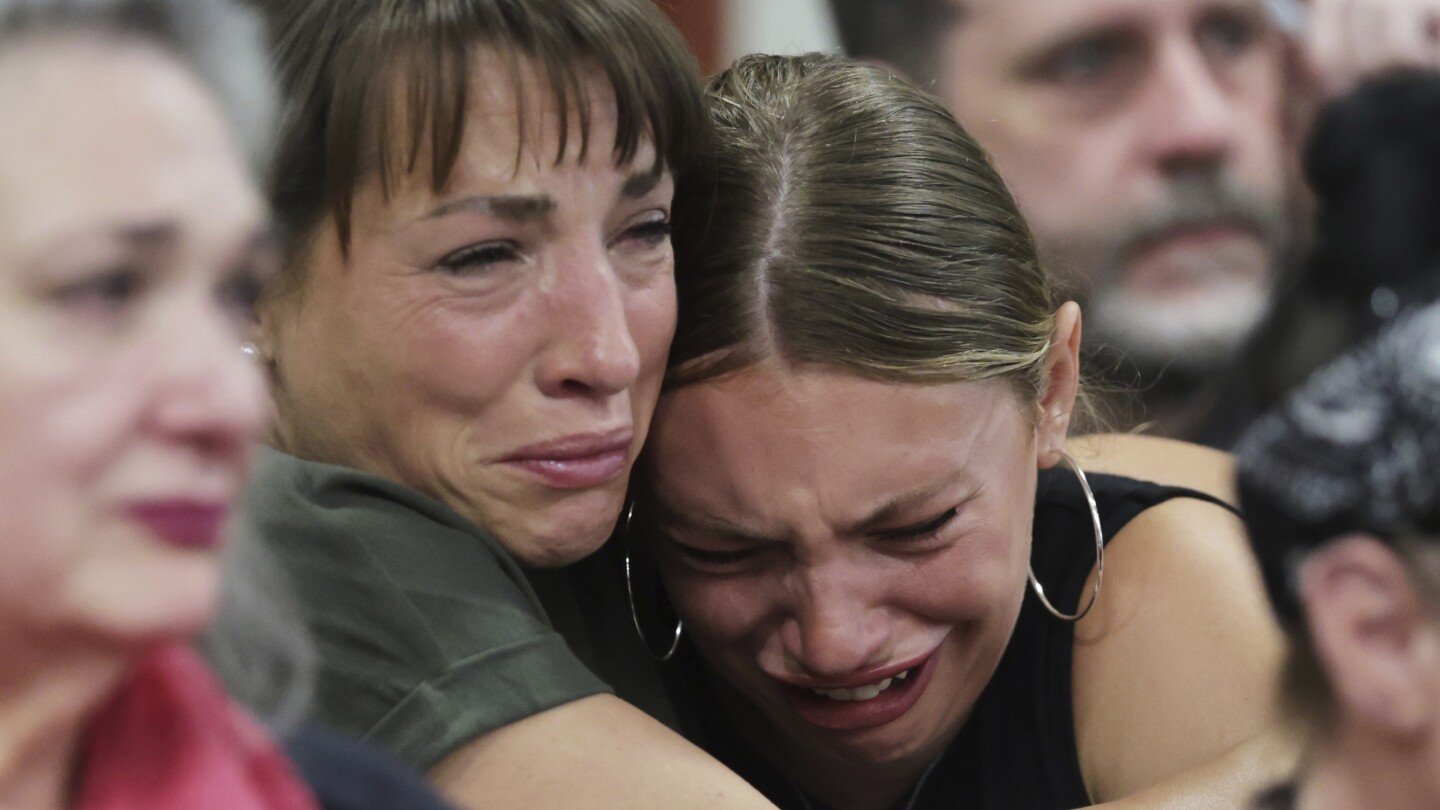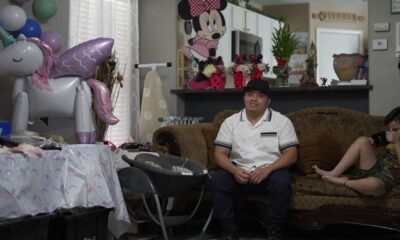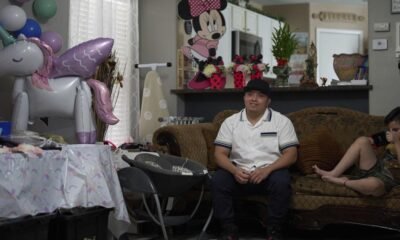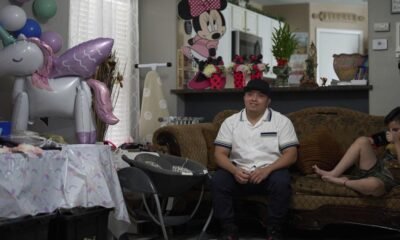Top Stories
Judge sentences Bryan Kohberger to life in prison for murdering four University of Idaho students

BOISE, Idaho (AP) — Friends and relatives of four University of Idaho students murdered in their rental home by Bryan Kohberger delivered powerful statements of love, anguish and condemnation as his sentencing hearing began Wednesday.
“This world was a better place with her in it,” Scott Laramie, the stepfather of Madison Mogen, told the court. ”Karen and I are ordinary people, but we lived extraordinary lives because we had Maddie.”
The father of Kaylee Goncalves taunted Kohberger for leaving his DNA behind and getting caught despite being a graduate student in criminology at nearby Washington State University at the time.
“You were that careless, that foolish, that stupid,” Steve Goncalves said. “Master’s degree? You’re a joke.”
Judge Steven Hippler ordered Kohberger to serve four life sentences without parole for the brutal stabbing deaths of Mogen, Goncalves, Xana Kernodle and Ethan Chapin early on Nov. 13, 2022. The defendant pleaded guilty early this month, just weeks before his trial was to start, in a deal to avoid the death penalty.
Kohberger broke into the home through a kitchen sliding door and brutally stabbed the four friends, who appeared to have no connection with him. No motive has been offered, and Kohberger chose not to speak at the hearing.
Dylan Mortenson, a roommate who told police of seeing a strange man with bushy eyebrows and a ski mask in the home that night, sobbed as she described how Kohberger, seated across the room in an orange jumpsuit, “took the light they carried into each room.”
“He is a hollow vessel, something less than human,” Mortenson said. “A body without empathy without remorse.”
Mortenson and another surviving roommate, Bethany Funke, described crippling panic attacks and anxiety after the attack.
“I slept in my parents’ room for almost a year, and had them double lock every door, set an alarm, and still check everywhere in the room just in case someone was hiding,” Funke wrote in a statement read by a friend. “I have not slept through a single night since this happened. I constantly wake up in panic, terrified someone is breaking in or someone is here to hurt me, or I’m about to lose someone else that I love.”
Alivea Goncalves’s voice didn’t waver as she asked Kohberger questions about the killings, including what her sister’s last words were. She drew applause after belittling Kohberger, who remained expressionless as she insulted him.
“You didn’t win, you just exposed yourself as the coward you are,” Alivea Goncalves said. “You’re a delusional, pathetic, hypochondriac loser.”
Kohberger’s mother and sister also attended the hearing, sitting in the gallery near the defense table. His mother quietly wept at times as the other parents described their grief. She sobbed briefly when Maddie Mogen’s grandmother said that her heart goes out to the other families, including Kohberger’s.
Xana Kernodle’s aunt, Kim Kernodle, said she forgave Kohberger and asked him to call her from prison, hoping he would answer her lingering questions about the killings.
“Bryan, I’m here today to tell you I have forgiven you, because I no longer could live with that hate in my heart,” she said. “And for me to become a better person, I have forgiven you. And any time you want to talk and tell me what happened, get my number. I’m here. No judgment.”
Police initially had no suspects in the killings, which terrified the rural western Idaho city of Moscow. Some students at both universities left mid-semester, taking the rest of their classes online because they felt unsafe.
A knife sheath left near Mogen’s body had a single source of male DNA on the button snap, investigators said, and surveillance videos showed a white Hyundai Elantra near the rental home around the time of the murders.
Police used genetic genealogy to identify Kohberger as a possible suspect and accessed cellphone data to pinpoint his movements the night of the killings. Online shopping records showed Kohberger had purchased a military-style knife months earlier, along with a sheath like the one at the home.
Kohberger was arrested in Pennsylvania about six weeks after the killings.
Both the investigation and the case drew widespread attention. Discussion groups proliferated online, members eagerly sharing their theories and questions about the case. Some armchair web-sleuths pointed fingers at innocent people simply because they knew the victims or lived in the same town. Misinformation spread, piling additional distress on the already-traumatized community.
Top Stories
‘Someone needs to answer for what happened’: Lisbon reacts to streetcar crash that killed 16 | Portugal

António Azevedo was in central Lisbon early on Wednesday evening, waiting to gather enough tourists for a ride in his tuk-tuk, when he heard what sounded like dozens of glass containers being dropped into rubbish trucks.
The driver looked around Restauradores Square but saw no trucks, only smoke rising from the lower station of the Elevador da Glória funicular railway, 100 metres from where his vehicle was parked.
Azevedo and other local business owners dashed to the scene to find that one of the Glória trams had derailed and crashed into a building in Avenida da Liberdade, Lisbon’s main artery.
Shocked, disoriented and unsure of what to do amid all the screaming and crying, the helpers began picking up metal pieces from the ground, wondering if they should try to lift what remained of the car’s main structure in case survivors were trapped beneath it.
One fellow rescuer passed a bleeding young boy to Azevedo, who held him as he cried for his father. Soon after, police and firefighters arrived at the scene and ordered Azevedo and the others not to touch or move anything.
“I remember looking around – the crying and the screaming gave way to complete silence,” said the 45-year-old driver. “There was a mountain of bodies that were not asking for help. They no longer moved; some were torn apart. I had never seen anything like it.”
Mohammad Farid rushed down from his souvenir store in Restauradores Square to help. But for many, it was already too late.
“We wanted to rescue people, to save lives,” Farid said. “But no one was asking for help because they were dead. They were dead in seconds.”
By Thursday morning, the scene of the accident – in which 16 people died and 21 were injured – was filled with flowers and candles to honour the dead and mark the national day of mourning declared by the Portuguese government.
The list of people caught up in the disaster reflected its international dimension. As well as Portuguese citizens, those being treated in hospital included people from Canada, Cape Verde, France, Germany, Italy, Morocco, South Korea, Spain and Switzerland. Prosecutors said on Thursday evening that the dead included five Portuguese citizens, two Koreans and one Swiss national.
A group of local people standing close by the site were discussing what could have caused the tragedy. In the 1970s, Argentina Pereira, now 80, used to work in the Suisso Atlântico Hotel in Rua da Glória, where the tram derailed.
She talked of the strain the funicular had been under since Lisbon began to establish itself as one of Europe’s biggest tourist magnets over the past decade.
“I used to take the funicular four times a day [in the 1970s],” she said. “It was a beautiful time, and a different time. Now they allow more than 40 people aboard, but back then, no more than 20 people could travel at the same time. I think 40 is probably too much, and if they want it that way, they should do periodic inspections every two weeks.”
Azevedo also felt the tragedy should lead to increased checks.
“I think that cities that receive a lot of tourists must guarantee high safety [standards] with this kind of infrastructure,” he said. “This is old infrastructure, and someone needs to answer for what happened.”
Although Carris, the municipal public transport company that operates the service, said “all maintenance protocols” had been carried out – including daily inspections and monthly and weekly service programmes – some visitors to Lisbon said they had been put off by the appearance of the funicular.
John Heron, a 75-year-old Australian who was on holiday in the Portuguese capital with his wife, Brenda, said he had thought the trams looked “dodgy” when he spotted them from the top of the hill of Rua da Glória a few days before the accident.
“In Australia, we have very high-quality regulation systems, and I am not so sure the same is true here in Portugal and for a lot of older infrastructures in Europe,” he said. “When I first saw the Glória funicular, it looked very unsafe, but I am not an engineer; it was just a feeling. When I saw the news, I thought, ‘Lucky we ended up staying at the hotel yesterday afternoon, or who knows if we would have ended up deciding to take the ride’.”
Others were also counting their blessings. Cristián Morgado, a 31-year-old tourist from neighbouring Spain, had been planning to ride the route on Wednesday afternoon with his partner, Soraya Navarro. In the end, they decided to do it in the morning.
“Since we saw what happened, we can’t stop thinking that it could have been us if we hadn’t changed our minds,” said Navarro, 30.
Despite Wednesday’s crash, which Portugal’s prime minister, Luís Montenegro, described as “one of the biggest tragedies in our recent history”, Morgado doubts tourists will be put off from visiting Lisbon.
“I don’t think this will affect tourism much,” he said. “Spain has a similar situation with overtourism, and now we are having a serious issue with pickpocketing, and foreigners know and that hasn’t stopped them.”
In a few weeks, he said, foreigners would probably have forgotten about all this. “Portuguese people won’t, but tourists will.”
Top Stories
Live updates: DOJ probes mortgage fraud claims against Federal Reserve governor, AP source says – AP News

- Live updates: DOJ probes mortgage fraud claims against Federal Reserve governor, AP source says AP News
- Exclusive | DOJ Opens Criminal Investigation Into Fed’s Cook, Issues Subpoenas The Wall Street Journal
- Trump Live Updates: Lisa Cook Investigation, Fed Board Hearing and More The New York Times
- Justice Department opens criminal investigation into Federal Reserve Governor Lisa Cook: Sources ABC News
- Justice Department issues subpoenas targeting Fed governor Trump is trying to oust The Washington Post
Top Stories
Lululemon (LULU) Q2 2025 earnings

Sign at the entrance to the Lululemon store in Midtown Manhattan.
Erik Mcgregor | Lightrocket | Getty Images
Lululemon shares plunged in extended trading Thursday after the company gave a much worse than expected full-year outlook.
The company topped second-quarter earnings estimates but slightly missed revenue expectations. But it said it expected tariffs to hit its full-year profits by $240 million.
Lululemon said it expects full fiscal year earnings of $12.77 to $12.97 per share, well below Wall Street estimates of $14.45 per share. It also anticipates full-year revenue of $10.85 billion to $11 billion, compared with Wall Street expectations of $11.18 billion.
“We are facing yet another shift today within the industry related to tariffs and the cost of doing business,” CEO Calvin McDonald said on a call with analysts. “The increased rates and removal of the de minimis provisions have played a large part in our guidance reduction for the year.”
Here’s how the company did for its second quarter compared with what Wall Street was expecting, based on a survey of analysts by LSEG:
- Earnings per share: $3.10 vs. $2.88 expected
- Revenue: $2.53 billion vs. $2.54 billion expected
Shares of the company sank more than 10% after the bell Thursday. The stock is down more than 45% this year.
Programming note: Lululemon CEO Calvin McDonald will be interviewed exclusively on CNBC’s “Squawk on the Street” on Friday.
The company reported second-quarter net income of $370.9 million, or $3.10 per share, compared to $392.92 million, or $3.15 per share, in the year-ago period. Gross margin decreased 1.1 percentage points to 58.5%, and operating margin decreased 210 basis points to 20.7%.
Same-store sales in the Americas were down 4%. Overall comparable sales increased just 1% compared to Wall Street estimates of 2.2%. Lululemon said it added 14 net new stores during the second quarter, bringing its total to 784 stores.
It projects third-quarter revenues will be between $2.47 billion and $2.50 billion compared to Wall Street estimates of $2.57 billion. The company said it expects earnings per share in the next quarter to be between $2.18 and $2.23 per share, compared to an estimate of $2.93 per share.
McDonald said on the Thursday call that he believes the company has let its product lifecycles “run too long,” particularly in its lounge and social categories.
“We have become too predictable within our casual offerings and missed opportunities to create new trends,” he said.
“Our lounge and social product offerings have become stale and have not been resonating with guests,” McDonald added.
-

 Business6 days ago
Business6 days agoThe Guardian view on Trump and the Fed: independence is no substitute for accountability | Editorial
-
Tools & Platforms3 weeks ago
Building Trust in Military AI Starts with Opening the Black Box – War on the Rocks
-

 Ethics & Policy1 month ago
Ethics & Policy1 month agoSDAIA Supports Saudi Arabia’s Leadership in Shaping Global AI Ethics, Policy, and Research – وكالة الأنباء السعودية
-

 Events & Conferences4 months ago
Events & Conferences4 months agoJourney to 1000 models: Scaling Instagram’s recommendation system
-

 Jobs & Careers2 months ago
Jobs & Careers2 months agoMumbai-based Perplexity Alternative Has 60k+ Users Without Funding
-

 Education2 months ago
Education2 months agoVEX Robotics launches AI-powered classroom robotics system
-

 Funding & Business2 months ago
Funding & Business2 months agoKayak and Expedia race to build AI travel agents that turn social posts into itineraries
-

 Podcasts & Talks2 months ago
Podcasts & Talks2 months agoHappy 4th of July! 🎆 Made with Veo 3 in Gemini
-

 Podcasts & Talks2 months ago
Podcasts & Talks2 months agoOpenAI 🤝 @teamganassi
-

 Education2 months ago
Education2 months agoMacron says UK and France have duty to tackle illegal migration ‘with humanity, solidarity and firmness’ – UK politics live | Politics





















